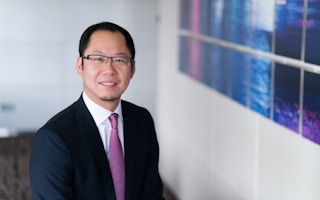The “megatrend” of sustainable finance today will be conventional finance for the next generation of leaders tomorrow, predicts long-time banker Eric Lim, chief sustainability officer and managing director of group finance for UOB.
Lim was appointed as the bank’s first chief sustainability officer (CSO) to lead its dedicated sustainability office in April 2021. This role is concurrent with his two other positions as managing director of group finance at UOB and chairman of UOB’s group sustainability committee.
He calls business leaders and politicians who are leaning into sustainability a “conversion generation”: they are moving into sustainable finance from conventional finance to respond to stakeholders’ belief of what is right.
“But in 10 to 15 years’ time, the next generation of C-suites, board members and politicians will be those who grew up with sustainability as a given. In that world, conventional financing is sustainable financing. Conventional products will be sustainable products. In that world, if your product build or business model is not sustainable, you will be called out,” said Lim.
The belief that sustainable finance will be mainstream has guided UOB’s policy towards helping the world decarbonise. In 2019, UOB, which is Singapore’s third largest bank, committed to stop financing coal-fired power plants. Last year, it exceeded its goal to build a sustainable finance portfolio of $15 billion by 2023. This has led them to raise their sustainable finance target for 2025 to $30 billion.
In July, UOB reported that its sustainable finance portfolio reached S$20 billion as at Q2 this year. This more than tripled from S$6.6 billion at the end of 2019. Meanwhile, the bank’s overall loan portfolio grew at just under 10 per cent a year.
Under UOB’s sustainable finance frameworks, loans are directed towards projects and activities that address the climate and drive social development. These frameworks help to guide clients in shaping sustainability strategies for their businesses.
Their sustainable finance frameworks comprise circular economy, green buildings, green and sustainable trade finance, smart cities and transition finance; as well as sustainable deposits.
In this interview, Lim shares the vision and thinking behind UOB’s sustainability strategy, touching on issues such as the importance of transition finance and how the bank deals with concerns on greenwashing.
How did UOB’s sustainability office come about, and how did you get appointed to head it?
At the beginning of last year, UOB’s board and chief executive officer (CEO) [Wee Ee Cheong] decided to bring a greater focus to the sustainability of the bank. There were a lot of ongoing conversations about sustainability, including sustainability at the risk level, the wholesale bank level, the property level, etc., but [sustainability] was not brought together under a single strategic unit.
To streamline the bank’s sustainability efforts, UOB set up a corporate sustainability office to be responsible for the overarching sustainability strategy across the bank, and I was appointed to lead it as CSO.
Things have changed so fast. In the last year and a half as CSO, the transformation in the sustainability sector has been huge. I’ve had to learn so much about new technologies that I feel like I’d gone back to high school or college.
As a bank, we have to be very clear ourselves what sustainability meant to us. It meant forging a sustainable future, across the Asean region, together with our clients. That became our North Star and basis to powering innovation across Asean for a sustainable future.
Early on, we had to figure out which areas of sustainability had the most potential to help clients decarbonise. We could then provide financing more quickly and seamlessly to clients working with our ecosystem partners (across U-Solar, U-Energy and U-Drive) as we had already pre-screened and curated their capabilities and possible solutions for their needs for their switch to more sustainable solutions.
How have mindsets shifted in sustainability?
About three to four years ago, going sustainable was still seen as “doing good”, and one would have to give up profit maximisation and incur more costs in order to do that. Today, the conversation has shifted. Stakeholders – including national governments, regulators, investors and clients – demand more sustainability, not less.
The new winning business models in the sustainable future will be purposeful, right, responsible environmentally and socially, but still making a profit.
In the last two years, our sustainable finance portfolio has increased three times, compared to our conventional finance portfolio, which has increased at less than 10 per cent per year.
What does transition finance entail, and how does it add value to sustainable finance?
Transition finance is where we provide financing to help hard-to-abate or high-carbon sectors – such as oil, gas, coal power generation companies – transition from existing high-carbon business models towards low-carbon or net-zero models such as solar, wind, geothermal or hydrogen.
The first challenge is that we need to ensure that the client has a clear transition plan, and that we, as a bank, know that we are truly financing a transition from high-carbon to low-carbon assets, and not just prolonging high-carbon assets.
The second challenge is that transition financing comes with a fair amount of reputational risk. Banks that lend money to high-carbon sectors [who are transitioning to low-carbon assets] will immediately come under challenge from institutional investors who are focused on sustainability, as well as NGOs and the public.
Nevertheless, transition financing is critically important. In developing Asia, for example, you cannot switch off high-carbon sectors overnight and continue to provide reliable, affordable energy. We need to help players do it well, or we’ll be stuck in the high-carbon economy for much longer than we should.
How can banks lead the way in helping companies decarbonise?
For the last 100 years, what has been driving economic development has largely been based on fossil fuels. Any piece of technology we’ve had during this time lasted, on average, 20 years. This means we went through four or five technological replacements to get to where we are now.
But 2050 [the year by which countries in the Paris Agreement have pledged to move to net-zero carbon emissions] is in 28 years. We don’t have the luxury of time to go through five more industrial revolutionary cycles. In one generation, we’ll have to invest and replace all we’ve done in the last 100 years.
Financial institutions can help speed up the shift from older, carbon-intensive technologies into areas of new technologies, as this requires massive amounts of investment.
“
2050 is in 28 years. We don’t have the luxury of time to go through five more industrial revolutionary cycles. In one generation, we’ll have to invest and replace all we’ve done in the last 100 years.
Eric Lim, chief sustainability officer, UOB
Has UOB, being an Asian bank, been more equipped to handle ESG investing in the region as compared to more “global” banks?
Asean is in a developing part of the world, and banks need to deliver sustainability in line with economic development. Balancing decarbonisation with a just transition is critically important for this part of the world.
Unlike the EU or the US, which are both blocs, Asean is made up of vastly different countries with their unique cultures, characteristics, starting points and development paths. As an Asian bank, we have good on-the-ground relationships. We understand how to work within these countries’ cultures to influence, cajole and lead, and these are critical factors in cracking sustainability for each country.
We are also relevant with the national governments within the banking industry. We know the available technologies, regulatory environments, the main economy players with good track records, then we can lend into the sectors that can assist and accelerate in building the infrastructure.
As a Singapore-domiciled bank, we have gateway access between the East and the West, and North Asia and Southeast Asia. Hence we can help to bridge the gap between capital markets that finance and accelerate the sustainability infrastructure in Asean.
How can institutions that deal with sustainable financing avoid accusations of greenwashing?
One of the most comforting things that the board [of UOB], as well as the management committee, told me when I started as CSO was not to worry about the headline numbers, but just to focus on creating positive environmental and social impact through what we could do.
Sustainable finance providers will have to expose themselves to feedback from institutional investors and stakeholders, allow themselves to be challenged. In this way, people will genuinely respect that engagement and give constructive feedback. If you become defensive, and overmarket or overbrand, you will get called out.
If you’re merely hunting for reputation, revenue or branding, you will not be able to build the right kind of impact. But if you keep true to your North Star, you’ll be able to build an authentic sustainability strategy that focuses on creating positive environmental and sustainable impact.















